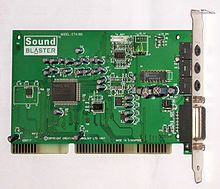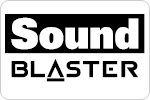Sound blaster
Sound Blaster is a trademark of Creative Labs . In the 1990s in particular, Sound Blaster sound cards for IBM-compatible PCs were widespread. At that time these computers only had hardware for simple beeping noises, mostly with a simple built-in speaker . Only additional cards made it possible to output sound in hi-fi quality. Most games could only play music and sounds on Sound Blaster and compatible cards.
The Sound Blaster cards were the first sound cards for IBM-compatible PCs after AdLib , and they became widely used. The manufacturer Creative Labs established a de facto - standard for IBM PC sound cards. The Sound Blaster cards were particularly popular for game applications under MS-DOS .
With the introduction of Windows and a driver model , it was possible to use virtually any add-on cards, provided the manufacturer supplied a Windows driver. As a result, the dominance of the Sound Blaster cards fell rapidly.
history
In 1989 Creative Labs released the first Sound Blaster card. The production in the Far East and the relatively simple hardware design made it possible to offer the card at a comparatively low price. There was also successful marketing.
The predecessor of the sound blaster was the "Creative Music Systems" (CMS) sound card with 12 voices that appeared in 1988 and was marketed by Markt + Technik in German-speaking countries . On the American market it was renamed Game-Blaster soon after it was released . The price was around 400 DM . The price and the manageable support provided by games meant that the card was not widely used.
The Sound Blaster cards possessed a digital-to-analog and analog-to-digital converter for output and recording of audio samples , one for competitors AdLib compatible FM Synthesizer ( Yamaha YM3812 ), a sound mixer and a flexible programmable digital signal processor for Control of the output and recording of digital samples . In addition, was mostly game port - Interface integrated for connecting gaming input devices to the alternatively MIDI could be connected devices. The first Sound Blaster cards could optionally be equipped with CMS chips in order to achieve compatibility with the older Game Blaster cards.

At times - starting with the Sound Blaster 16 - a 26-pin wave blaster interface was installed in order to be able to expand the sound generation of the Sound Blaster card by plugging in a wavetable board with wavetable synthesis . Creative Labs disclosed the specifications of the interface, so that the Sound Blaster card could not only be equipped with Creative Labs' own Wave Blaster boards (versions 1 and 2) but also with expansion cards from third-party providers that were usually much better in terms of sound quality (e B. Yamaha DB50XG, Roland SCB-7, Roland SCB-55).
For the first time, the Sound Blaster AWE32 offered a programmable wavetable synthesizer on the card itself. As a result, it took up almost the maximum length allowed for ISA cards in the computer. An EMU8000 chip from E-mu Systems was used as the synthesizer . The wavetable RAM could be expanded almost at will with inexpensive SIMM modules via two slots . Extensive sysex commands and MIDI control data even enable the AWE to be controlled directly via the sequencer. A comprehensive editor (Soundblaster Vienna) included in the delivery also allows you to create your own wavetables.
A big advantage was the possibility of direct memory access (Engl. Direct Memory Access, DMA). The digital signal processor fetches the audio data independently, i. H. without support from the main processor, from the main memory of the computer. This process is called DMA transfer . In simple terms, the central processor only has to trigger the sound output by informing the signal processor where the audio data is located in the main memory. After that, it may only be necessary to ensure at regular intervals that the signal processor there is also a sufficient amount of audio data available. To ensure this, the signal processor can trigger a so-called interrupt in good time before the audio data runs out. This is also the reason why sound cards use a so-called IRQ channel. In response to this request, the main processor can reload new audio data into the main memory and inform the signal processor where it is located. For the continuous output of audio data, this process can be repeated as often as required without overloading the main processor.
Many NoName manufacturers were soon forced to build Sound-Blaster-compatible sound cards, as their own standard would not have been able to assert itself on the market due to a lack of software support. Only a few manufacturers - such as Gravis with the Gravis Ultrasound and MediaVision with the “Pro Audio Spectrum” series (PAS) - defied this trend. However, when MS-DOS lost its importance as a platform for computer games , the Sound Blaster standard no longer played a major role, since Windows introduced an audio API (first Windows Multimedia API, then DirectSound ).
Models
Important series with some models in chronological order that were responsible for the success of the Sound Blaster:
- Game Blaster, originally Creative Music System ("C / MS" or "CMS" for short) (CT1300, CT1300B)
- Sound Blaster 1.0 (CT1310, CT1320A, CT1320B)
- Sound Blaster 1.5 (CT1320C, CT1320U)
- Sound Blaster 2.0 (CT1350)
- Sound Blaster Pro (CT1330)
- Sound Blaster Pro 2 (CT1600, CT1610, CT1620, CT1690, CT2600)
- Sound Blaster 16 (various models, ISA and PCI)
- Sound Blaster 32 / AWE 32 / AWE 64 (various models, ISA and PCI)
- Sound Blaster 128 (various models, including: Vibra, CT4810, CT5803)
- Sound Blaster Live! 128/512/1024 / Player / Value / 5.1 / 24-bit
- Sound Blaster Audigy with Audigy 2, 2 ZS and 4 Pro
- Sound Blaster X-Fi (XtremeAudio / XtremeMusic / Platinum / Fatal1ty FPS / Elite Pro / XtremeGamer Fatal1ty Professional Series / XtremeGamer)
- Sound Blaster X-Fi Titanium / Titanium Fatal1ty Pro / Titanium Fatal1ty Champion
- Sound Blaster X-Fi Titanium HD
- Sound Blaster Recon3D Professional / Fatal1ty / Fatal1ty Champion
- Sound Blaster Z / Zx / ZxR
The first sound cards were operated via the XT bus and the ISA bus . Starting with the Sound Blaster 16 , there were also models for the PCI bus and later for USB and PCI Express . For notebooks there is a model for the PCMCIA slot and one for the ExpressCard . For most of the models there were or are different versions aimed at different user groups. Cards for the ISA bus often also contained an additional IDE interface for connecting a CD-ROM drive.
Today the Sound Blaster series represents a range of sound cards for the middle and upper user area, which can be completely covered by the current X-Fi series.
Dedicated sound cards, such as B. the Sound Blaster X-Fi Xtreme Audio contribute to the improvement of the sound compared to typical onboard sound chips . In addition, models are available that are optimized for special applications such as computer games (Xtreme Gamer) , music editing (Xtreme Elite Pro) or for listening to music and playing DVDs (Xtreme Music) . Some models have a front panel that can be used to connect additional devices. A number of products from the subsidiary E-mu Systems exist for professional applications .
Apart from the first models that came onto the market before Windows, the cards are supplied with drivers for Windows, and in earlier times also for MS-DOS. Linux has supported most cards since Kernel 2.6, although not all functions can be used in some cases. For older kernel versions the drivers are available separately in the ALSA project.
USB audio devices
- Sound Blaster X-Fi GO! Per
- Sound Blaster X-Fi Surround 5.1 Pro
- Sound Blaster Digital Music Premium HD
- Sound BlasterAxx SBX 8 / SBX 10 / SBX 20
- Sound Blaster Play! 2
- Sound Blaster Omni Surround 5.1
- Sound Blaster R3
- Sound BlasterAxx AXX 200
- Sound Blaster Roar
- Sound Blaster Roar 2
- Sound Blaster Roar Pro
- Sound Blaster E1 / E3 / E5
- Sound Blaster X7
- Sound Blaster JAM
- Sound Blaster FRee
Individual evidence
- ↑ shock__: CT1310 model number for the Soundblaster 1.0 - a myth? . In: The Vintage Computer Forums. Vintage-Computer.com, February 9, 2011, accessed February 12, 2011 .





